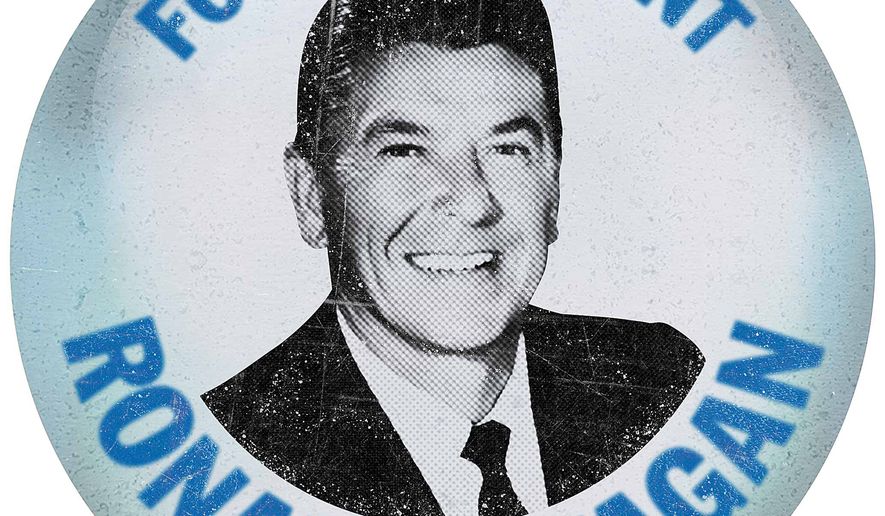OPINION:
Exactly 50 years ago, in a little-remembered Republican primary, Ronald Reagan achieved a remarkable political breakout. Only five months earlier, he had stunned the political world by beating incumbent Pat Brown, California Democrat, for the governorship of California — the nation’s most populous state — by almost one million votes.
Almost immediately, he and his campaign team in November 1966 had begun planning his first presidential campaign. Mr. Reagan would target three of the major Republican primaries for the spring of 1968, and the first was Wisconsin. It, along with Nebraska and Oregon, would have “Opt-out” primaries, in which persons considered by each of those three states to be candidates for the presidency would be listed on the primary ballots.
A candidate could opt out if she/he would formally declare that they were not seeking the presidency. Mr. Reagan, who would run as favorite son from California, thus had the perfect reason as to why he could not opt out and why his name would remain on the ballot.
Almost every weekend during 1967 and 1968, when he was free without state business in Sacramento, Mr. Reagan travelled across the nation at targeted destinations chosen by his campaign staff. He spoke at Republican fundraising events but at the same time, he and his team set up campaign offices and sought delegates. His goal was to stop a first-ballot Nixon victory at the August 1968 Republican convention.
For Mr. Reagan during that first presidential quest, his first test as a national candidate was to be Wisconsin’s April 2, 1968 primary. As luck would have it, the perfect conservative to lead Mr. Reagan’s Wisconsin effort had written a letter offering to help. A bank executive in Waukesha, whose major hobby was flying small planes, met with Mr. Reagan’s campaign director. As a result, the “Wisconsin Reagan for President Cub” was formed on April 28, 1967. That organizational document remains the first official legal form ever filed on behalf of the candidacy of Ronald Reagan for the presidency.
Mr. Reagan visited Milwaukee on Sept. 30, 1967. A huge crowd greeted Reagan at the airport, and Mr. Reagan met his Wisconsin campaign team at the Pfister Hotel. Later he gave a rousing speech about small government and individual freedom, which one local newspaper reporter described as, “one of the greatest speeches I ever have heard.” An informal Wisconsin poll done the next month showed Mr. Reagan now within six points of Nixon (34 percent vs. 28 percent) and with Mr. Reagan ahead of George Romney and Nelson Rockefeller.
By January 1968, columnists Rowland Evans and Robert Novak had a major article on Wisconsin Republicans published in Harper’s. By speaking to Republicans across the state, it was clear that initial support for Richard Nixon was ebbing as charismatic Ronald Reagan’s was gaining.
By the spring of 1968, Mr. Reagan’s core Wisconsin campaign team consisted of more than 400 enthusiastic Reagan volunteers, and the state director flew his plane several thousand miles across Wisconsin campaigning for Mr. Reagan. Mr. Reagan’s Wisconsin team then aligned with the Reagan National Information Center based in Topeka. Just before Election Day, the brand new campaign film, “Ronald Reagan, Citizen Governor,” blitzed the airways in Milwaukee and Green Bay. A final New York Times article title read, “Nixon Faces Threat from Reagan Camp in Wisconsin Voting.”
On April 2, 1968, Wisconsin Republicans voted. Gov. Reagan of California received 50,727 votes, 10.4 percent. Mr. Reagan’s Wisconsin manager remains quite proud to this day that the Reagan 1968 effort cost only $6516.70 and ended with a campaign surplus of $4.15.
Ronald Reagan’s first test as a national candidate outside of California was a huge success. He did not win, but winning was never the goal. Richard Nixon was certainly on top, but the affable and charismatic conservative, Ronald Reagan, had begun to close the gap. Because of Wisconsin, Mr. Reagan’s head was above the rest of the pack and he was seen for the first time as a national vote-getter and alternative to Mr. Nixon. For Mr. Reagan on his first presidential campaign, it was off to Nebraska and then Oregon, all in preparation for the 1968 Republican convention in Miami Beach.
• Historian Gene Kopelson is the author of “Reagan’s 1968 Dress Rehearsal: Ike, RFK, and Reagan’s Emergence as a World Statesman” (Figueroa Press, 2016)




Please read our comment policy before commenting.